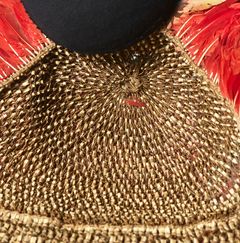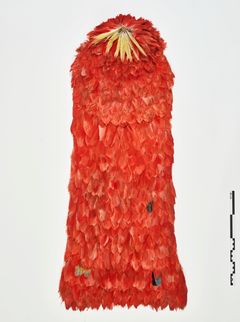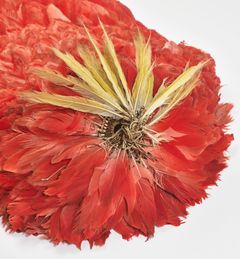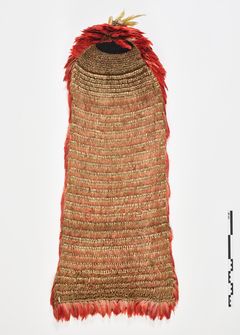The National Museum of Denmark to Donate Rare Feather Cape to Brazil
When it was ravaged by a massive fire in 2018, the National Museum of Brazil lost virtually its entire ethnographic collection. Now, the National Museum of Denmark is donating an extremely rare feather cape to Brazil to help with the rebuilding of the museum’s collection. The cape is one of the best-preserved examples of its kind in the world.
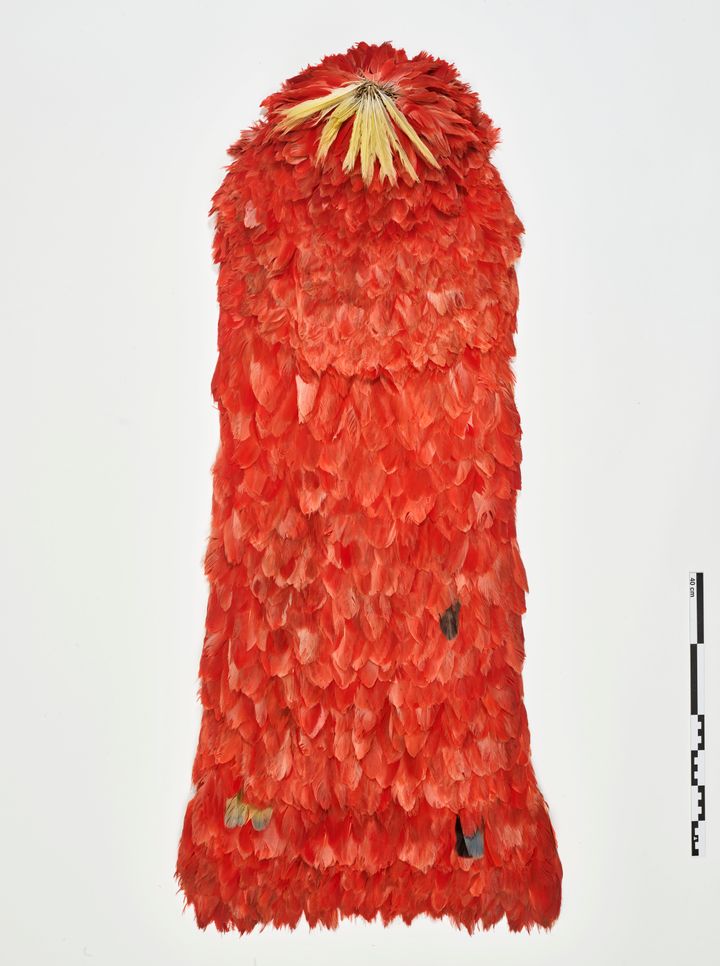
This extremely rare Brazilian, red feather cape, made of red ibis feathers, has been in Copenhagen for 300 years. Originally part of the King’s Kunstkammer, it is now a part of the National Museum of Denmark’s ethnographic collection.
There are only 11 so-called Tupinambá feather capes in the world – all in European museums – and the one in Copenhagen is regarded as one of the best preserved. Five of the capes are in the Danish National Museum’s collections.
The Tupinambá were one of the first indigenous peoples the Europeans encountered when landing on the east coast of Brazil. Today’s Tupinambá are pleased that their sacred feather cape is now returning to the National Museum of Brazil to become part of the national historical narrative.
The request from both the Tupinambá leaders and Museu Nacional in Rio de Janeiro has resulted in a donation from the National Museum of Denmark to the National Museum of Brazil, following fruitful discussion between all parties involved.
The iconic feather cape will be transferred permanently to the Museu Nacional/UFRJ in Rio de Janeiro as a “significant and unique contribution” by Denmark to the reconstruction of the Brazilian museum, which lost its collection in a devastating fire in 2018.
“Cultural heritage plays a decisive role in nations’ narratives about themselves and people’s self-understanding. This is the case all over the world. That is why it is important for us to help rebuild the National Museum of Brazil after the devastating fire a few years ago”, says Rane Willerslev, Director of the National Museum of Denmark.
"The donation of this very important Brazilian cultural item that has so much meaning for so many people, is the most important contribution so far for the new exhibition of the first museum of Brazil. We will honour and treasure it but for all made it accessible for the indigenous people," says Alexander Kellner, Director of the Museu Nacional/UFRJ.
“This historical collaboration between the two National Museums is also a milestone in the Brazil-Denmark cultural cooperation. It has been a privilege to me to supporting such a significant joint initiative with tremendous positive impact to Brazil’s collective memory and to our indigenous people tradition”, says Rodrigo de Azeredo Santos, Ambassador of Brazil to the Kingdom of Denmark.
Upon receiving the letter from Dr. Rane Willerslev, Director of the National Museum of Denmark, chief Tupinambá Babau said: “For us, the donation of the Tupinambá mantle means the return of an ancestor! It is also the return of hope that never dies: a concrete answer for those who believe in the strength of their people and continue to fight for their culture, secrets and religion. We continue to create other mantles. But now, by a generous donation, our greatest relic will return to Brazil! The bird that symbolizes this mantle, the ibis, which no longer exists in our region, is born and grows gray. When eating crabs, their feathers turn red. It is a sign of transformation that occurs in everything, human beings and their culture. Many thanks to the National Museum of Brazil and Denmark for allowing us to hear the sacred words of our ancestors again. The Cloak is back!"
The Museu Nacional is in the process of rebuilding its ethnographic archives and physical collections in close collaboration with the country’s indigenous peoples and museums outside Brazil. The National Museum of Denmark and a number of other European museums are already supporting the reconstruction by creating digital catalogues that will make Brazilian artefacts and archive material located in European museums available.
Alongside the donation, the two museums are entering into a cooperation agreement aimed at the development of joint research and interpretation/public engagement projects, including the digitalisation of the National Museum of Denmark’s Brazilian collections.
Heritage of the Tupinambá
When the Portuguese arrived in eastern Brazil in 1500, they encountered the Tupi-speaking people, including the Tupinambá. The encounter with the Europeans and their diseases in the 16th century was a hard blow for the Tupinambá people and led to a large decline in the population.
In 2001 the Tupinambá were recognised as an indigenous people in Brazil under the designation Tupinambá de Olivença. They live in southern Bahia and today probably number around 4,600 people, spread over several villages.
Originally, the cape was used in important religious rituals and other ceremonial contexts, which also feature in contemporary written sources, copper engravings and woodcuts. It represents the long history of the material culture and traditional crafts of the Tupinambá people and even today has indisputable historical, cultural, and spiritual significance for their identity.
The cape is also an essential source when it comes to researching Brazilian history.
“The feather cape has had a prominent place in our collection, but it has greater significance for the Brazilian population as a cultural symbol, as a material heritage of the Tupinambá and as evidence of Brazilian-European historical, colonial encounters. In Brazil, it will be available to the indigenous peoples who have a strong historical and cultural connection to it,” says Christian Sune Pedersen, head of research.
Before being transferred to Brazil, the cape will be thoroughly photographed, and scientific tests will be conducted, so that future research can determine its age, exact provenance, and material composition. The National Museum of Denmark will replace it in the exhibit with one or more Tupinambá feather capes that are currently in the museum’s storage.
The Museu Nacional will ensure optimal display and conservation conditions for the cape so research into it can continue, while also making it accessible to the Tupinambá and the people of Brazil.
Contact
The National Museum of Denmark - Cecilie Weinholt (Head of Communications ): +45 41206017 or cwe@natmus.dk
Contact the National Museum of Brazil - Alexander Kellner, +55-21-996725054, direcao@mn.ufrj.br
Contact the Brazilian Ambassador in Denmark
Keywords
Contacts
Cecilie Weinholt-LudvigsenNationalmuseet
Tel:41 20 60 17cwe@natmus.dkImages
Subscribe to releases from Nationalmuseet - Museer, forskning og bevaring
Subscribe to all the latest releases from Nationalmuseet - Museer, forskning og bevaring by registering your e-mail address below. You can unsubscribe at any time.
Latest releases from Nationalmuseet - Museer, forskning og bevaring
Ny forskning: Vigtig person fra Vindelev har været en del af den europæiske elite i jernalderen6.4.2024 06:00:00 CEST | Pressemeddelelse
En gård i den lille jyske by Vindelev har formentlig huset en meget vigtig og international personlighed, viser ny forskning i Vindelevskatten, som er udgivet i internationalt forskningstidsskrift.
Udbetaling af danefæ slår rekord for tredje gang på få år29.2.2024 06:00:03 CET | Pressemeddelelse
Der findes så mange historiske genstande, at udbetalingerne for danefæ slår rekord for tredje gang indenfor få år. Særligt unge, kvinder og endda familier har taget detektorhobbyen til sig og er dermed med til at redde genstande, før de risikerer at gå tabt.
Guldring afslører mulig ny fyrsteslægt i Sydvestjylland med alliance til Frankerriget19.2.2024 06:00:00 CET | Pressemeddelelse
Detektorfører har fundet sjælden guldring, der måske afslører en ny, ukendt fyrsteslægt ved Emmerlev i Sydvestjylland, der havde tæt forbindelse til datidens europæiske stormagt. Ringen er fundet i samme område som guldhornene, hvor en ukendt elite kan have regeret i flere hundrede år, mener arkæologer.
Jens-Kristian Lütken er nyt medlem i Nationalmuseets Museumsråd1.2.2024 09:58:00 CET | Pressemeddelelse
Nyt medlem i Museumsrådet for Nationalmuseet er Jens-Kristian Lütken, der er beskæftigelses- og integrationsborgmester i Københavns Kommune (V). Han indtræder i rådet den 1. februar 2024.
Nationalmuseet slår besøgsrekord og ansætter forskere5.1.2024 05:30:00 CET | Pressemeddelelse
Mere end to millioner var sidste år forbi Nationalmuseets besøgssteder, som dermed slår besøgsrekord. Samtidig forventer Nationalmuseet i år at ansætte samme antal forskere som før besparelsesrunden i 2022.
In our pressroom you can read all our latest releases, find our press contacts, images, documents and other relevant information about us.
Visit our pressroom
